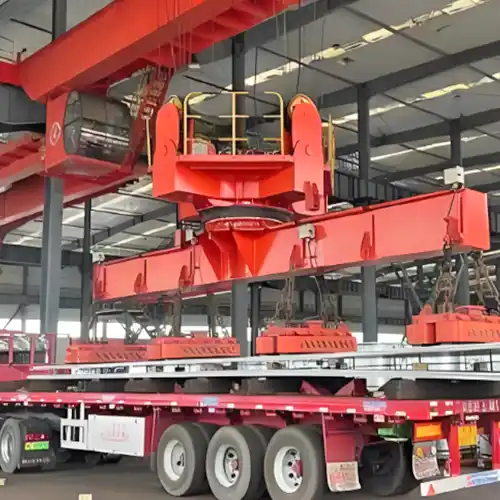Overhead Crane for Sale: Select Overhead Crane for Oil Refineries
Overhead crane for sale. Buying guide: All types of bridge cranes, gantry cranes, jib cranes & electric hoists. Select right crane and hoist for oil refineries.
Category: Oil & Gas
Your Trusted Overhead Crane Manufacturer & Supplier
Overhead Crane for Sale 1 Ton to 50 Ton: Select Overhead Crane for Oil Refineries
Overhead crane for sale. Buying guide: All types of bridge cranes, gantry cranes, jib cranes & electric hoists. Select right crane and hoist for oil refineries.
Comprehensive Guide: Selecting Overhead Cranes for Oil Refineries
Overhead cranes play a pivotal role in the operations of oil refineries, facilitating the efficient movement and handling of heavy materials and equipment. These cranes are instrumental in various refinery tasks, including construction, maintenance, material handling, and safety compliance. Typically suspended from the ceiling, overhead cranes utilize a bridge-like structure with a hoist and trolley mechanism, allowing for horizontal movement along the length of the crane.
In the field of oil refineries, overhead cranes are customized to meet specific operational demands, considering factors such as refinery layout, material handling requirements, environmental conditions, and safety standards. They come in various configurations and designs tailored to suit diverse refinery applications, such as top running cranes for heavy lifting during construction, jib cranes for precise handling in maintenance areas, gantry cranes for tank farm operations, and specialized cranes for hazardous or corrosive environments.
These cranes are designed to optimize material handling efficiency, enhance safety protocols, and minimize operational downtime within oil refineries. Their adaptability and versatility make them indispensable assets, contributing significantly to the streamlined workflow, increased productivity, and a safer work environment in the dynamic and challenging setting of oil refinery operations.
Significance of Selecting the Right Overhead Crane Types
Selecting the appropriate overhead crane types is more than a mere procurement decision; it's a strategic choice that significantly impacts refinery processes. Each crane type possesses unique capabilities tailored to specific tasks, ensuring optimal performance and safety within the refinery environment.
Overview of Overhead Crane Types for Oil Refineries
In the multifaceted landscape of oil refineries, an array of overhead crane types stands ready to meet the diverse demands of material handling. Each crane type boasts unique features and functionalities, tailored to address specific tasks within refinery settings. Let's explore these variations in detail:
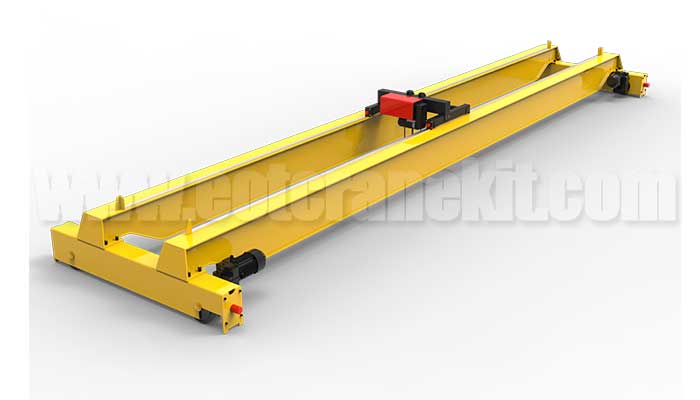
- Overview: Overhead cranes are prevalent in oil refineries, featuring a bridge-like structure that spans the area to be covered. They are highly versatile and come in various configurations, such as single girder or double girder designs, based on lifting capacity and specific application requirements within the refinery.
- Typical Crane Designs and Configurations: Single girder and double girder overhead cranes are commonly used in refineries. Single girder cranes are suitable for moderate lifting capacities, while double girder cranes offer higher lifting capabilities.
- Typical Functions and Applications in Oil Refineries: Used for general material handling, lifting heavy equipment, transporting materials during construction, and aiding in maintenance activities within refinery workshops, warehouses, and maintenance areas.
- Typical Loads Handled and Load Features: Overhead cranes handle a wide range of loads, including machinery, steel structures, tools, spare parts, and various materials used in refinery operations. Load features depend on the specific crane design and lifting capacity.
- Typical Workshop or Facility Where Crane Installed: Overhead cranes can be found in refinery workshops, maintenance areas, storage facilities, and construction sites within the refinery.
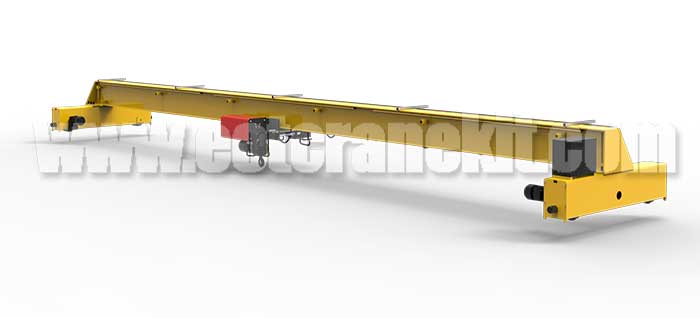
- Overview: Top running cranes are a type of overhead crane where the crane bridge runs along the top of the runway beams. They offer robustness and stability and are suitable for heavy lifting capacities.
- Typical Functions and Applications in Oil Refineries: Used for heavy lifting operations, transporting large equipment, and handling heavy loads during construction and maintenance phases within the refinery.
- Typical Loads Handled and Load Features: Top running cranes handle heavy machinery components, steel structures, and other substantial equipment used in refinery construction and maintenance.
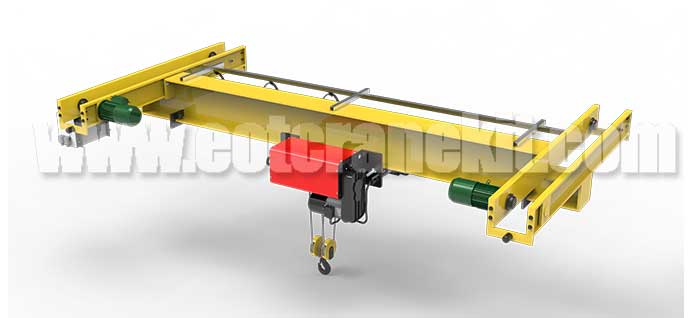
- Overview: Underhung cranes have their wheels or end trucks attached to the bottom flange of runway beams. They are often used in areas with limited headroom or where the crane needs to be integrated into existing structures.
- Typical Functions and Applications in Oil Refineries: Underhung cranes are utilized in workshops, smaller storage areas, or locations with limited space within the refinery.
- Typical Loads Handled and Load Features: They handle moderate loads, tools, spare parts, and smaller equipment required for daily refinery operations.
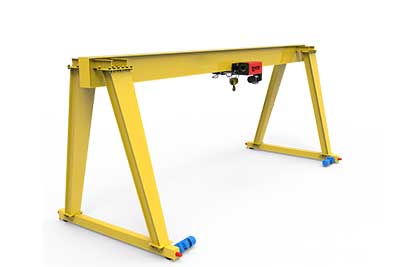
- Overview: Gantry cranes have a bridge that spans between two supporting legs. They are commonly used in tank farms for loading, unloading, and handling heavy loads.
- Typical Functions and Applications in Oil Refineries: Used for loading and unloading bulk materials, containers, or drums within the tank farm operations of the refinery.
- Typical Loads Handled and Load Features: Gantry cranes handle substantial weights associated with transporting and storing oil-based products, crude oil, refined petroleum products, and chemicals used in the refining process.
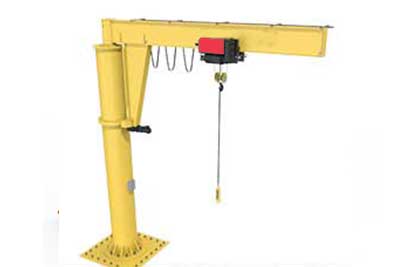
- Overview: Jib cranes have a vertical mast or wall-mounted structure with a rotating boom, offering precise lifting and placement of equipment or materials in specific locations within the refinery.
- Typical Functions and Applications in Oil Refineries: Used for localized material handling, precise positioning of heavy components during assembly, maintenance, or repair operations within the refinery.
- Typical Loads Handled and Load Features: Jib cranes handle various loads requiring precise placement, aiding in assembly, maintenance, or repair operations within specific areas of the refinery.
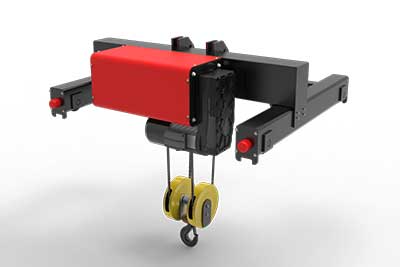
Electric hoists are lifting devices that can be integrated into various crane systems, including overhead cranes, gantry cranes, or jib cranes. They provide the lifting mechanism for these crane types and can handle different load capacities depending on their design and specifications. Electric hoists are used for lifting and moving loads within oil refineries, complementing the functionalities of the overhead crane systems in place.
Specialized Overhead Cranes fo Oil Refineries
In oil refineries, several specially designed overhead cranes are utilized within workshops or facilities to meet specific requirements and address unique challenges associated with the refining process. Some of these specialized overhead cranes include:
Explosion-Proof Cranes: These cranes are designed to operate in hazardous environments where the presence of flammable gases or vapors is a concern. They are equipped with features to prevent the risk of ignition, such as sealed electrical components, spark-resistant materials, and specialized enclosures to contain potential explosions.
Corrosion-Resistant Cranes: In environments where corrosive substances like acids are present, corrosion-resistant cranes are used. They are constructed with materials and coatings that withstand corrosion caused by exposure to chemicals or corrosive elements commonly found in the refinery setting.
Grab Cranes: Grab cranes feature specialized grabbing mechanisms or attachments used for handling bulk materials, such as sand, aggregates, or other granular substances commonly used in refining processes.
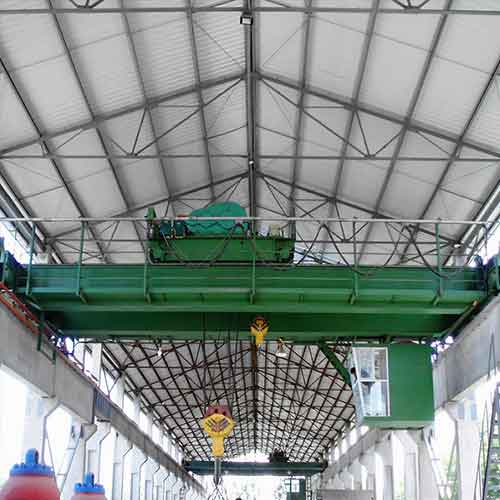
- Overview: Explosion-proof cranes are designed to operate safely in environments where the presence of flammable gases, vapors, or dust could potentially cause an explosion. They feature components and construction that minimize the risk of ignition.
- Typical Crane Designs and Configurations: These cranes come in various configurations, including overhead, gantry, or jib cranes, with specialized features to prevent sparks or ignition in potentially hazardous environments.
- Typical Functions and Applications in Oil Refineries: Utilized in areas where flammable substances are present, such as refineries' processing units or storage areas where hazardous materials are handled.
- Typical Loads Handled and Load Features: Explosion-proof cranes handle loads similar to standard cranes but are specifically designed to ensure safety in potentially explosive environments.
- Typical Workshop or Facility Where Crane Installed: Installed in areas of the refinery where flammable gases, vapors, or dust may be present, such as processing units, chemical storage areas, or zones classified as hazardous.
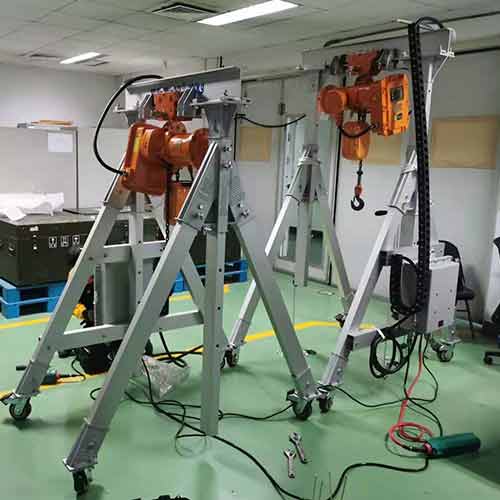
- Overview: Corrosion-resistant cranes are designed with materials and coatings that protect against corrosion caused by harsh environmental conditions, such as exposure to corrosive substances or extreme weather.
- Typical Crane Designs and Configurations: These cranes can be of various types like overhead, gantry, or jib cranes, equipped with materials and coatings resistant to corrosion, ensuring longevity in corrosive environments.
- Typical Functions and Applications in Oil Refineries: Used in areas where exposure to corrosive substances is prevalent, such as near chemical storage tanks, acid processing units, or in coastal refinery locations susceptible to saltwater corrosion.
- Typical Loads Handled and Load Features: Similar to standard cranes but designed to withstand and resist corrosion from exposure to harsh chemicals, moisture, or corrosive elements present in the refinery environment.
- Typical Workshop or Facility Where Crane Installed: Installed in areas within the refinery where corrosion is a concern, such as chemical processing units, areas with high humidity, or locations exposed to corrosive elements.
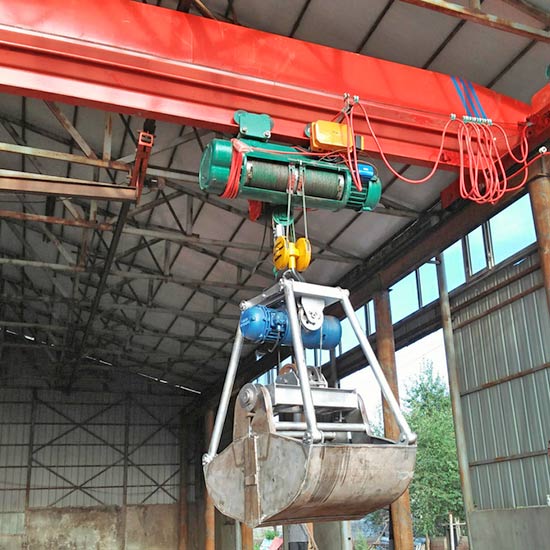
- Overview: Grab cranes are specialized cranes equipped with a grab or grapple attachment at the end of the lifting mechanism, allowing them to grasp and lift bulk materials, containers, or items that can be grabbed.
- Typical Crane Designs and Configurations: Grab cranes come in various configurations, often as gantry or overhead cranes equipped with a grabber attachment specifically designed for picking up bulk materials.
- Typical Functions and Applications in Oil Refineries: Used for loading and unloading bulk materials such as coal, ore, sand, or other granular materials in refining operations or storage areas.
- Typical Loads Handled and Load Features: Grab cranes handle bulk materials and are equipped with grabbing mechanisms suitable for various materials, offering efficient loading and unloading capabilities.
- Typical Workshop or Facility Where Crane Installed: Installed in areas of the refinery involved in handling bulk materials or in locations where loading/unloading operations of bulk goods are required, such as storage yards or processing units dealing with raw materials.
Tailoring Crane Selection for Refinery Operations
When it comes to outfitting an oil refinery with overhead cranes, a one-size-fits-all approach falls short. Refinery-specific needs and operational demands necessitate a tailored selection process. Let's delve into the crucial aspects to consider when choosing the optimal crane types for refinery operations:
Analyzing Refinery-Specific Needs
Refinery Layout and Size
Assessment: Conduct a comprehensive evaluation of the refinery's layout, considering factors such as available space, structural constraints, and layout complexity.
Feasibility: Determine the feasibility of crane installation by assessing spatial constraints and identifying suitable areas for crane placement.
Required Reach: Measure the required span and lifting heights necessary for the crane to efficiently cover and handle materials across the refinery's operational areas.
Material Handling Requirements
Material Types: Identify the diverse types of materials handled within the refinery, including raw materials, finished products, heavy machinery, containers, and bulk materials.
Quantities: Determine the quantities of materials to be handled, considering the volume and frequency of material movements within different refinery areas.
Handling Processes: Evaluate the handling processes to understand the specific tasks the crane will perform, such as loading, unloading, stacking, or transferring materials between different sections.
Environmental Conditions (Corrosion, Explosion Risks)
Location Analysis: Assess the refinery's geographic location and environmental conditions, including proximity to coastal areas, potential exposure to corrosive agents, and risk levels for explosion or fire hazards.
Corrosion Risks: Determine if the refinery operates in a corrosive environment due to exposure to saltwater, chemicals, or harsh weather conditions that may affect crane longevity.
Explosion or Fire Hazards: Identify areas with a higher risk of explosions or fire hazards within the refinery, requiring specialized cranes designed for safety in such environments.
Safety and Compliance Standards
Regulatory Compliance: Ensure adherence to safety regulations and industry standards specific to the oil refinery sector, including local, national, and international safety guidelines.
Industry-Specific Standards: Consider refinery-specific safety standards and protocols established by regulatory bodies or industry associations relevant to crane operations in refinery settings.
Safety Features: Select crane types equipped with safety features aligned with refinery safety standards, such as explosion-proofing, fire-resistant materials, or corrosion-resistant coatings.
By thoroughly analyzing these refinery-specific needs, oil refineries can pinpoint the exact requirements for overhead cranes. This process enables the selection of the most suitable crane types and configurations that align with operational demands, environmental considerations, and safety standards within the refinery setting.
Guidance on Choosing Optimal Crane Types
Refinery Construction and Installation Phases: Top Running Cranes
Overview: Top Running Cranes are the go-to choice for handling heavy lifting tasks during refinery construction and installation phases. They boast robustness, high lifting capacities, and versatility, making them indispensable in maneuvering heavy machinery and equipment across construction sites.
Benefits:
Ability to handle substantial loads with ease.
Ideal for construction projects due to their high lifting capacities.
Versatile movement across expansive construction areas.
Maintenance and Repair Activities: Jib Cranes
Overview: Jib Cranes offer precision and localized support, making them invaluable in refinery maintenance areas. Their ability to rotate and provide precise handling facilitates the safe and efficient maneuvering of equipment and components during maintenance and repair tasks.
Benefits:
Precision handling for maintenance operations.
Maneuverability in confined maintenance spaces.
Localized support for efficient part handling.
Tank Farm Operations: Gantry Cranes
Overview: Gantry Cranes are indispensable in tank farms for loading and unloading bulk materials. Their bridge spanning between supporting legs enables efficient handling of containers, drums, or bulk materials, optimizing storage and distribution operations.
Benefits:
Efficient loading/unloading of bulk materials in tank farms.
Optimization of storage operations in refinery yards.
Versatility in handling different types of materials.
Handling Hazardous Materials: Explosion-Proof Cranes
Overview: In areas prone to explosion risks, Explosion-Proof Cranes become crucial. These cranes adhere to stringent safety standards, ensuring safety and uninterrupted operations in hazardous environments where the risk of explosions exists.
Benefits:
Mitigation of explosion risks in hazardous areas.
Compliance with safety regulations in high-risk environments.
Uninterrupted operations in critical refinery sections.
Corrosive Environments: Corrosion-Resistant Cranes
Overview: Corrosion-Resistant Cranes are specifically designed to withstand harsh environments like coastal refineries prone to saltwater corrosion. These cranes maintain durability and functionality in corrosive conditions, reducing maintenance costs and ensuring operational longevity.
Benefits:
Prolonged crane lifespan in corrosive environments.
Reduced maintenance costs and operational downtime.
Sustained operational efficiency in harsh conditions.
By aligning crane selections with specific refinery needs and operational demands, oil refineries can significantly enhance material handling efficiency while ensuring compliance with safety standards and industry regulations.
Maximizing Crane Efficiency in Refinery Applications
Overhead cranes play a crucial role in various processes within oil refineries, facilitating material handling, lifting heavy equipment, and aiding in maintenance tasks. Different types of overhead cranes are utilized in oil refineries, each serving specific purposes in different procedures:
Refinery Construction and Maintenance:
Double Girder Overhead Crane: This type of crane is used during the construction phase and maintenance of the refinery. It has two girders mounted on parallel runways, providing high lifting capacities and versatility. These cranes handle heavy equipment, construction materials, and components during refinery erection and repair.
Construction Phase:
Heavy Equipment Handling: Double girder cranes are utilized for lifting and transporting heavy machinery required in the construction of refinery structures. This can include large components of distillation units, reactors, columns, and other substantial equipment.
Steel Structure Erection: These cranes are essential for lifting and placing steel beams, columns, and other structural elements during the construction of refinery units.
Material Transportation: They assist in the movement of construction materials such as steel plates, pipes, concrete blocks, and other supplies across the construction site.
Maintenance Phase:
Equipment Repair and Replacement: Double girder cranes are instrumental in handling equipment repair and replacement tasks within the refinery. They lift and relocate heavy machinery for maintenance, repair, or replacement, ensuring smooth operation of refinery units.
Lifting Heavy Components: During maintenance shutdowns or turnarounds, these cranes are vital for handling and replacing critical components like heat exchangers, vessels, pumps, and other large pieces of equipment.
Versatile Usage: Their design and lifting capacity make them versatile for various maintenance tasks, providing support in handling tools, spare parts, and other equipment required for routine upkeep or emergency repairs.
The double girder overhead crane's dual-girder configuration offers increased stability, better control, and higher lifting capacities compared to single girder cranes. They operate along parallel runways, enabling smooth movement and precise positioning of heavy loads during both construction and maintenance activities in oil refineries. These cranes are designed to withstand the demanding conditions of refinery environments and contribute significantly to the efficiency and safety of construction and maintenance operations.
Material Handling in Refinery Operations:
Single Girder Overhead Crane are commonly used for general material handling in various areas of the refinery. They have a single girder and are suitable for lifting moderate loads in workshops, warehouses, or maintenance areas. Jib cranes are mounted on a vertical mast or wall-mounted, offering a rotating boom that allows precise lifting and placement of equipment or materials in specific locations within the refinery.
Single Girder Overhead Crane:
General Material Handling: These cranes are versatile and commonly used for lifting and transporting moderate loads within various sections of the refinery, including workshops, warehouses, and maintenance areas.
Efficient Movement of Loads: Single girder cranes are suitable for moving materials such as tools, spare parts, smaller equipment, and other supplies necessary for daily refinery operations.
Space-Saving Design: Their compact design and single girder make them suitable for areas with limited headroom or where space constraints are a concern.
Jib Crane:
Precise Material Placement: Jib cranes are mounted on vertical masts or walls, providing a rotating boom that offers precise lifting and positioning of equipment or materials in specific locations within the refinery.
Localized Handling: They excel in tasks requiring localized material handling or specific placement of heavy components, aiding in assembly, maintenance, or repair operations.
Enhanced Maneuverability: Jib cranes' ability to rotate and swing the boom allows for greater flexibility in reaching different spots within a limited radius.
These types of cranes are essential for day-to-day operations within the refinery. While single girder overhead cranes efficiently handle general material movement in various areas, jib cranes offer more precise and localized handling capabilities, providing flexibility in handling tasks requiring specific positioning or placement of materials or equipment. Their usage aids in maintaining operational efficiency and streamlining processes within the refinery environment.
Tank Farm Operations:
Gantry Crane: Gantry cranes are used in tank farms for loading and unloading bulk materials, containers, or drums. They have a bridge that spans the area between two supporting legs and can handle heavy loads during tank operations.
Purpose in Tank Farm Operations:
Loading and Unloading Operations: Gantry cranes are specifically employed for loading and unloading bulk materials, containers, or drums onto trucks, railcars, or within storage areas within the tank farm.
Handling Heavy Loads: They are designed to handle substantial weights commonly associated with the transportation and storage of oil-based products, including crude oil, refined petroleum products, chemicals, or other materials used in the refining process.
Spanning Capabilities: Gantry cranes feature a bridge that spans the area between two supporting legs, providing wide coverage and allowing them to access multiple storage tanks or areas within the tank farm.
Specific Functions:
Versatile Handling: Gantry cranes facilitate the movement of various types of loads, including large containers, drums, pallets, or bulk materials, adapting to the diverse needs of tank farm operations.
Efficient Loading and Unloading: Their design and lifting capabilities ensure efficient and timely loading and unloading of materials, optimizing the logistics and distribution process within the tank farm.
Support during Maintenance: These cranes may also be used to assist in the maintenance of storage tanks or handling equipment required for repairs or inspections.
Gantry cranes are equipped with lifting mechanisms such as hooks, grabs, or specialized attachments to handle different types of loads efficiently. Their ability to move heavy loads across the tank farm area makes them essential in ensuring the smooth operation of storage and distribution processes within the refinery. Properly maintained and operated gantry cranes contribute significantly to the overall efficiency and safety of tank farm operations in oil refineries.
Main Functions of overhead cranes in oil refineries
In the intricate tapestry of oil refinery operations, the efficiency and safety of material handling significantly rely on employing the right crane types across various operations. Let's navigate through the optimal utilization of overhead cranes in diverse refinery applications:
Utilizing Cranes in Different Refinery Operations
Overhead cranes are commonly used in oil refineries and various industrial sectors within the oil and gas industry. These cranes play a vital role in handling heavy loads, equipment, and materials throughout the refining and processing operations. They are employed for various tasks such as:
- Equipment Maintenance: Overhead cranes are used for lifting and moving heavy machinery and components during maintenance and repair activities within the refinery, such as replacing parts in distillation towers, reactors, or other processing units.
- Material Handling: They facilitate the movement of raw materials, intermediate products, and finished goods within the refinery. This includes transporting pipes, drums, containers, and other materials needed for refining processes.
- Assembly and Installation: Overhead cranes help in the assembly and installation of new equipment or components, including positioning large structures or parts in place during construction or expansion projects.
- Safety and Emergency Response: In emergency situations or maintenance shutdowns, these cranes may be used to swiftly move equipment or materials to ensure safety or address urgent operational needs.
- Loading and Unloading: Overhead cranes are utilized for loading and unloading heavy materials or products onto trucks, ships, or storage areas within the refinery complex.
These cranes come in various types and configurations depending on the specific requirements of the refinery, such as bridge cranes, gantry cranes, or jib cranes. They are designed to handle substantial weights and are equipped with safety features to ensure smooth and secure lifting operations in potentially hazardous industrial environments like oil refineries.
Equipment Maintenance:
Overview: Overhead cranes are used for lifting and moving heavy machinery and components during maintenance and repair activities within the refinery, such as replacing parts in distillation towers, reactors, or other processing units.
Types of Overhead Cranes Used: Bridge cranes, gantry cranes, and jib cranes are commonly used for equipment maintenance in oil refineries.
Typical Crane Capacity: Varies depending on the specific requirements of the refinery but can range from a few tons to several hundred tons.
Typical Functions and Application: These cranes are utilized to lift and position heavy machinery parts, large components, and equipment for maintenance purposes. They are crucial for supporting maintenance teams in safely conducting repairs and replacements.
Workshops Installed: Overhead cranes are commonly installed in maintenance workshops within the refinery premises to facilitate efficient equipment maintenance operations.
Material Handling:
Overview: Overhead cranes are essential for handling various materials within the refinery, including raw materials, intermediate products, and finished goods.
Types of Overhead Cranes Used: Bridge cranes and gantry cranes are predominantly used for material handling purposes in oil refineries.
Typical Crane Capacity: Ranges from light-duty to heavy-duty, depending on the specific material handling requirements.
Typical Functions and Application: These cranes are used to lift, transport, and position materials such as pipes, drums, containers, and other heavy items required for refining processes. They facilitate efficient movement of materials across different areas within the refinery.
Workshops Installed: Overhead cranes may also be installed in material storage areas or warehouses to handle the movement of materials effectively.
Assembly and Installation:
Overview: Overhead cranes play a crucial role in the assembly and installation of new equipment, structures, or components within the refinery.
Types of Overhead Cranes Used: Bridge cranes and gantry cranes are commonly used for assembly and installation purposes in oil refineries.
Typical Crane Capacity: Tailored to meet the lifting requirements for various installation tasks, ranging from moderate to heavy lifting capacities.
Typical Functions and Application: These cranes assist in lifting and positioning heavy structures, equipment, or components during construction or expansion projects within the refinery.
Workshops Installed: Cranes utilized for assembly and installation may be stationed in specific areas where construction or installation activities are ongoing.
Safety and Emergency Response:
Overview: Overhead cranes are sometimes utilized in emergency situations or safety-related tasks within the refinery.
Types of Overhead Cranes Used: Depending on the emergency response requirements, various types of cranes may be used.
Typical Crane Capacity: Varied capacities, often capable of handling emergency lifting needs swiftly.
Typical Functions and Application: In emergency situations, these cranes can be employed to move equipment or materials quickly and safely to ensure the well-being of personnel or to address urgent operational needs.
Workshops Installed: Emergency response cranes may be strategically located across the refinery to provide prompt assistance in case of emergencies.
Loading and Unloading:
Overview: Overhead cranes are used for loading and unloading heavy materials or products onto trucks, ships, or storage areas within the refinery complex.
Types of Overhead Cranes Used: Bridge cranes and gantry cranes are frequently used for loading and unloading purposes.
Typical Crane Capacity: Designed to handle various load capacities required for loading and unloading operations.
Typical Functions and Application: These cranes are employed to lift, position, and transfer heavy items or products onto transportation vehicles or storage areas within the refinery.
Workshops Installed: Overhead cranes used for loading and unloading may be positioned near loading docks or storage yards within the refinery for efficient logistics operations.
Advantages of Suitable Crane Types in Operations
Enhanced Productivity and Efficiency
Streamlined Material Handling: Utilizing crane types tailored for specific operations ensures efficient and precise material handling, reducing handling times and enhancing workflow.
Optimized Operations: Customized cranes with appropriate features improve operational efficiency by enabling faster load movements, reducing operational delays, and enhancing overall productivity.
Improved Safety Standards
Specialized Crane Design: Cranes specifically designed for each operation, considering safety factors like load capacity, environmental hazards, and precision handling, enhance overall safety measures.
Compliance with Safety Standards: Using cranes compliant with safety regulations mitigates risks, minimizes accidents, and ensures a safer working environment for refinery personnel.
Reduced Downtime and Workflow Optimization
Minimized Operational Interruptions: Deploying the right crane types reduces downtime due to breakdowns or inefficient handling, ensuring uninterrupted workflow and maximizing uptime.
Optimized Workflow: Customized cranes facilitate smoother and more efficient workflow processes, allowing for better coordination in material handling and operation sequences.
Overall Impact
By identifying and deploying the most suitable crane types for each operation within oil refineries, the cumulative impact results in a range of benefits:
Efficiency Gains: Optimized material handling processes lead to increased efficiency, minimizing time wastage and resource mismanagement.
Safety Enhancement: Tailored crane types mitigate risks associated with material handling, enhancing overall safety measures and fostering a secure working environment.
Productivity Boost: The synergy of enhanced efficiency, improved safety, and reduced downtime results in an overall increase in refinery output and operational effectiveness.
In summary, by strategically aligning crane types with specific refinery operations, oil refineries stand to gain multifaceted advantages. The enhanced material handling efficiency and heightened safety protocols not only optimize operations but also contribute to a safer, more productive work environment within the refinery setting.
Installation, Maintenance, and Safety Practices
The seamless operation and longevity of overhead cranes within oil refineries hinge upon meticulous installation, effective maintenance, and stringent safety protocols. Let's delve into the critical aspects of ensuring optimal performance and safety:
Importance of Proper Crane Installation
- Installation Procedures: - Detailed installation protocols specific to various crane types, ensuring structural integrity and operational efficiency.
- Safety Measures: - Implementing safety measures during installation to mitigate risks and ensure a secure working environment.
Implementing Effective Maintenance Practices
- Regular Checks: - Scheduled maintenance checks to monitor crane components, ensuring optimal functionality and detecting potential issues.
- Lubrication and Inspections: - Proper lubrication and thorough inspections to extend crane lifespan and prevent operational breakdowns.
- Compliance with Safety Regulations: - Adhering to safety regulations and manufacturer recommendations to maintain safe crane operations.
Emphasizing Safety Protocols and Operator Training
- Training Programs: - Comprehensive training programs for crane operators, emphasizing safety protocols, and operational best practices.
- Safety Measures During Operations: - Implementing safety measures during crane operations to mitigate risks and prevent accidents.
- Accident Prevention Strategies: - Strategies and protocols to prevent accidents and ensure a safe working environment for refinery personnel.
By prioritizing proper installation, regular maintenance, and stringent safety measures, oil refineries can ensure the smooth operation of overhead cranes while upholding safety standards and minimizing downtime.
Conclusion: Empowering Crane Buyers and Refinery Operators
As we conclude this comprehensive guide on selecting overhead cranes for oil refineries, let's recap the key insights and empower crane buyers and refinery operators with essential takeaways:
Throughout this guide, we've traversed the intricate landscape of overhead cranes within oil refinery settings. We explored various crane types, their functionalities, and their tailored applications across diverse refinery operations. Understanding the pivotal role of each crane type in construction, maintenance, material handling, and safety measures elucidates their significance in optimizing refinery processes.
Tailoring Crane Selection: Addressing refinery-specific needs and operational demands to choose the most suitable crane types for each operation.
Maximizing Efficiency: Leveraging the right crane types to enhance productivity, safety, and operational efficiency in different refinery scenarios.
Installation, Maintenance, and Safety: Prioritizing proper installation, regular maintenance, and stringent safety protocols to ensure optimal crane performance and workforce safety.
Real-Life Applications: Examining case studies and real-life examples showcasing successful crane implementations, highlighting their practical benefits in refinery settings.
Encouraging Continuous Improvement
Empowerment comes with knowledge and continuous learning. For crane buyers and refinery operators, staying abreast of advancements in crane technology, safety standards, and industry best practices is crucial. Encouraging continual learning and informed decision-making in selecting, operating, and maintaining overhead cranes fosters a culture of efficiency, safety, and innovation within oil refineries.
In this ever-evolving landscape of refinery operations, the quest for optimal efficiency and safety remains constant. By embracing innovation, adopting best practices, and adapting to evolving needs, refinery personnel and crane buyers can propel their operations toward higher productivity, enhanced safety standards, and sustained success.
As the oil refinery industry continues to evolve, staying informed, proactive, and adaptable in crane selection and operation will serve as the cornerstone for continued growth and advancement.
Related Products

Latest project
150 Ton Overhead Crane Installation Feedback – Paraguay Case
QDX 150 ton overhead crane in action in Paraguay. Installation photos, video, and client feedback show performance, safety, and heavy-lifting efficiency.
Free consultation to Confirm Parameters & Specifications and Get
Latest Crane Price & Crane Rate.
- Types of overhead cranes : _______?
- Optional: Overhead travelling crane, goliath gantry crane,Slewing jib crane, Single girder or double girder crane,small portable crane or kbk crane, etc.
- Capacity of overhead crane: _______?
- Optional: 0.25ton, 0.5 ton, 1 ton, 2 ton, 3ton, 5 ton, 10 ton,15ton, 20ton, 25 ton, 30ton,35ton, up to 550ton, etc.
- Crane span & lifting height : _______?
- Crane travelling length : _____?
- Control of overhead crane:_______?
- Optional: pendant/ remote/cabin control
- Voltage supply of overhead crane:_____?
- Eg,: 380V50/60HZ,3Phase or others,etc.
- Application/usage of crane:_______?
- Eg,: Steel mill, ,injection mold, cement,stone, concrete,granite, general manufacturing, etc.
Just leave a message via the contact form and our hoist and crane engineer will contact you with in 24working hours.
Get In Touch
